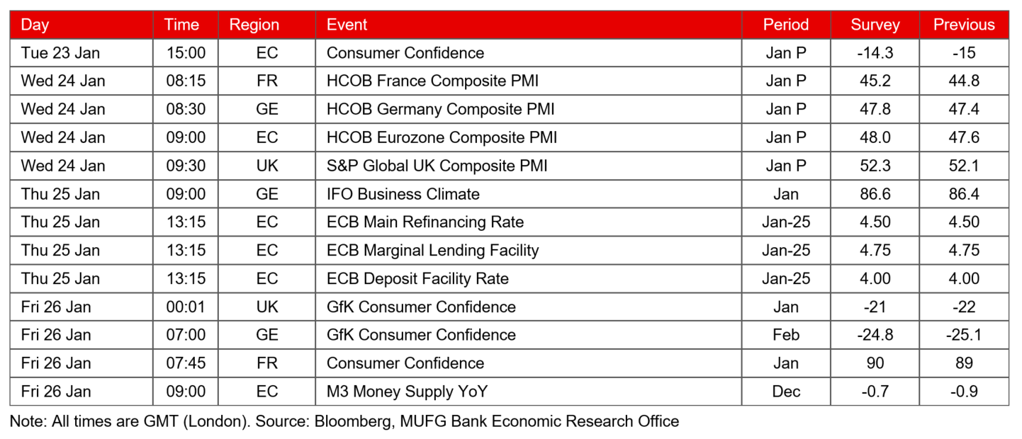- UK inflation edged higher in December, but this was likely just a blip. Food and energy prices should drive headline inflation lower this year. At the same time, wage growth continues to slow and there’s evidence that underlying price pressures are also easing. However, the possibility of tax cuts, sticky service prices and the increase in the minimum wage will probably deter BoE officials from declaring victory over inflation just yet.
- The German economy shrank in 2023 according to the official annual estimate. The broader picture remains one of stagnation with Germany lagging behind its peers when it comes to the post-pandemic recovery. The prospect of lower interest rates may boost confidence this year but we still expect only modest growth in 2024.
- Next week the focus will be on the ECB policy meeting. Recently officials have been attempting to push back against market expectations for rate cuts early this year. With the euro area close to technical recession and inflation set to ease in coming months this may become an increasing tough task.
The disinflation process is set to continue in the UK
UK headline inflation surprised to the upside in December, edging up from 3.9% to 4.0%. This was largely driven by alcohol and tobacco prices after an increase in duty was announced in November. The core inflation rate held steady at 5.1%, although services inflation ticked up to 6.4%. The increase in the headline rate – the first in 10 months – is a reminder that the disinflation process could be bumpier in 2024 than it was last year. Indeed, the increase in UK inflation mirrors the surprise upticks seen in both the US and the euro area last month. The headline UK rate is likely to increase again, slightly, in January after some unusual services price increases at the start of 2023 (as flagged by the BoE in the minutes of its December meeting).
However, the general trend for headline inflation is likely to remain downwards through the year. Lower wholesale gas prices point to a 10-15% fall in household energy prices from April under the UK’s energy price cap system. Input price data suggests that consumer food prices should also continue to ease through the year. This means that, after much talk about the UK’s relative inflation problem (see here), the headline rate of UK inflation could fall back to the BoE’s 2% target by the summer.
In terms of policy implications, the Q4 average CPI rate of 4.2% easily undershoots the BoE November forecast (4.6%). A sizeable downgrade to the BoE’s headline CPI projection in the February update is therefore likely (Chart 1). There’s also evidence that underlying price growth is easing: our seasonally-adjusted core rate edged down to 2.3% on a 3m/3m annualised basis. That said, the BoE will still be wary about the possibility of sticky services inflation. Many mobile and broadband contracts will increase in April by the December rate of CPI plus 3.9pp (i.e. 7.9%).
Meanwhile, official wage growth has fallen but remains uncomfortably high from a monetary policy perspective at 6.6% (ex. bonuses, 3M Y/Y) in November (Chart 2). The timelier PAYE estimate for December suggested that total pay growth may have edged up at the end of the year, and we know that the UK minimum wage will increase by 9.8% from April. We also expect some tax cuts in the Spring Budget on 6 March ahead of the upcoming UK election – which would see fiscal and monetary policy pulling in opposite directions. Against that background, the BoE may be reluctant to make a dovish pivot much before its May policy meeting. Markets are currently pricing in around four and a half rate cuts in 2024.
Chart 1: The BoE is set to revise its CPI projections lower in the February MPR
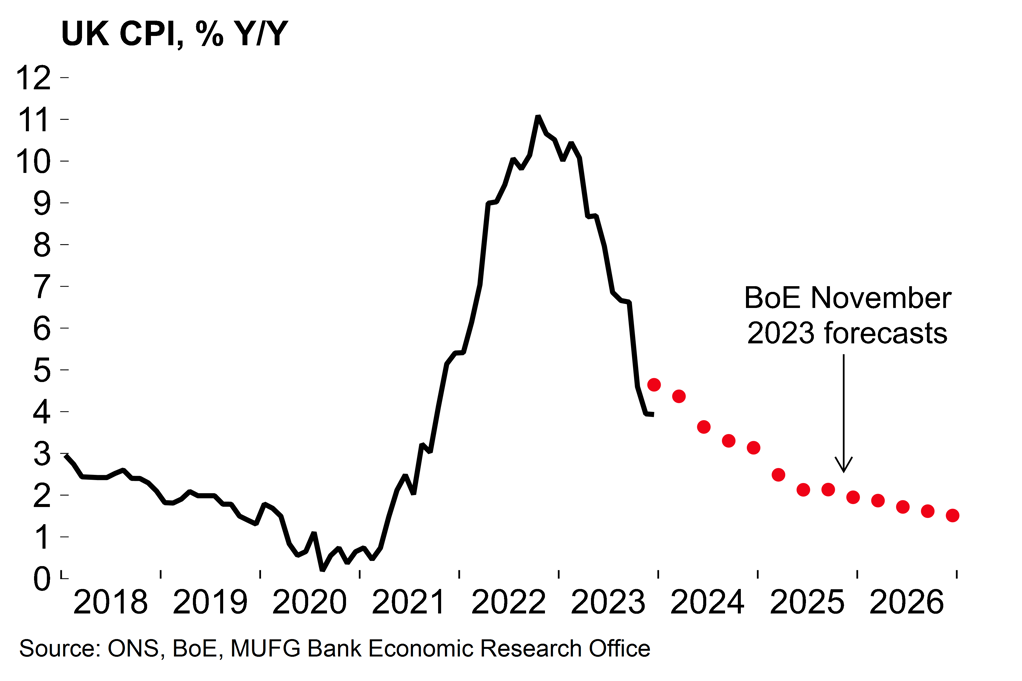
Chart 2: Nominal pay growth has probably peaked
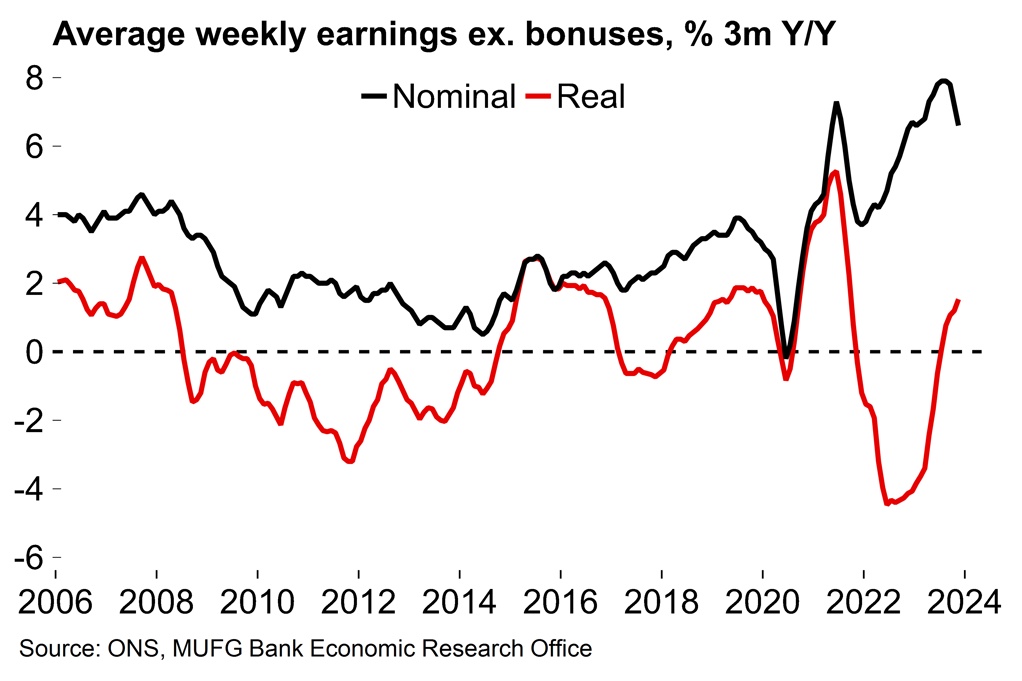
UK data this week also revealed that retail sales plunged by 3.2% M/M in December. There are probably some issues with the seasonal adjustment process as consumers increasingly bring forward Christmas shopping to November (+1.3% M/M) to make the most of Black Friday discounts. However, retail sales still fell by around 0.9% across the quarter as a whole in volume terms. We wrote last week that the UK economy is teetering close to a technical recession in Q4 (see here). These latest retail figures have tilted the balance and make a mild recession now look more likely than not in the absence of any revisions to the historical data. Looking ahead, we are more optimistic for consumer spending and growth more broadly as real household incomes continue to recover (real pay growth is now around 1.5% Y/Y), but it is clear that the UK economy carried little momentum into 2024.
The German economy stagnated in 2023
The German economy contracted by 0.3% in 2023 as a whole, according to the advance annual estimate published by the Federal Statistics Office, which was in line with our estimate. The weakness was broad-based. Consumer spending was down by 0.8% across the year as inflation eroded purchasing power and government spending also slumped following the scaling back of COVID-related measures. Net exports contributed positively – but only because of a larger contraction in imports (-3.0%) than exports (-1.8%).
It was estimated that GDP fell by 0.3% Q/Q in Q4. The Q3 number was revised up from -0.1% to no growth (0.0%). For what it’s worth, this means that the German economy may have just about avoided slipping into a technical recession (the official national accounts data for Q4 will be released on 30 January). However, the bigger picture remains the same: the German economy has clearly stagnated. GDP has increased by just 0.7% since 2019 as higher interest rates, energy costs and weaker foreign demand have weighed on activity. Germany is clearly at the back of the pack when it comes to the post-pandemic economic recovery in G7 economies (Chart 3).
Chart 3: The German post-pandemic recovery has lagged behind its peers
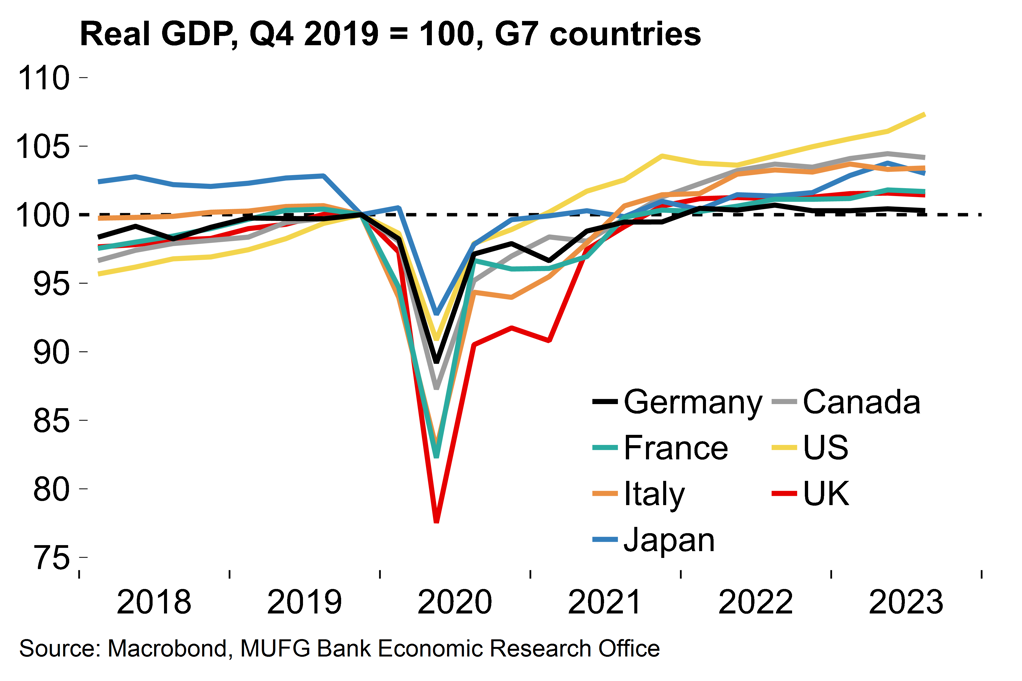
Chart 4: Structural pressures continue to weigh on the German industrial sector
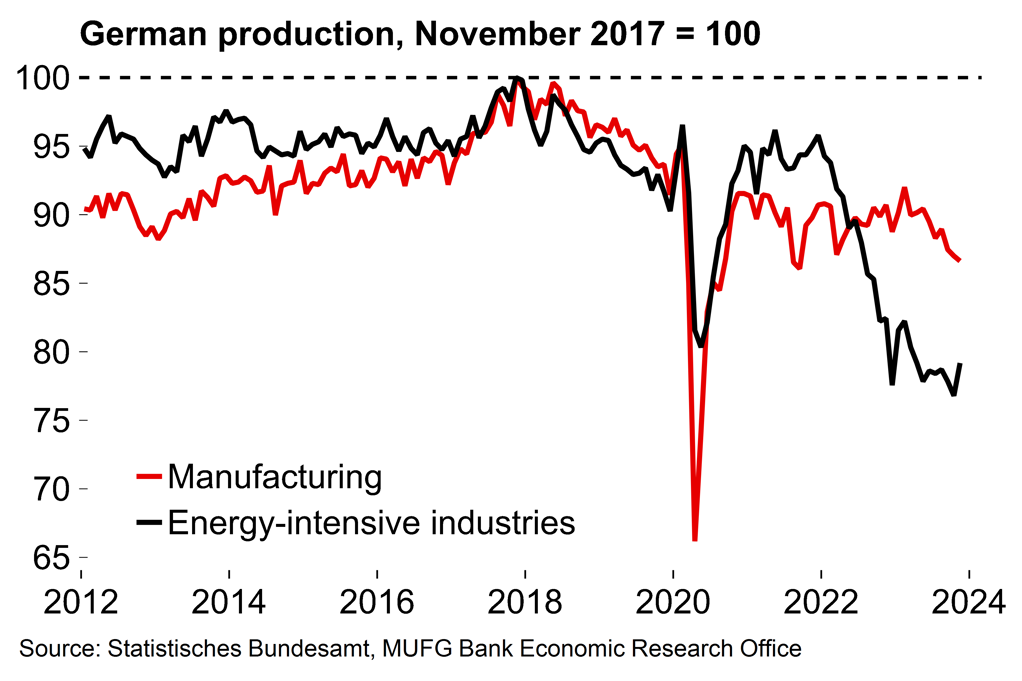
We expect some improvement in growth in 2024, especially in H2. Consumer spending should benefit from a recovery in real household income growth as the disinflation process continues. Business confidence is likely to benefit from lower interest rates (the ZEW expectations gauge increased in January on the back of strengthening expectations for ECB rate cuts). However, structural challenges for the industrial sector (Chart 4) are likely to persist (see here) and external demand is unlikely to surge higher. Our current forecast is for annual average growth of 0.6% in 2024. We will likely revise this lower at our next forecast update if Q4 GDP is confirmed at -0.3% Q/Q due to the likely negative carry-over effect.
How long will the ECB continue to push back against rate cut speculation?
Since pausing the hiking cycle in September 2023, ECB officials have pushed back against rate cut speculation in an attempt to keep financial conditions tighter for longer. The holding pattern is now breaking down. This week, President Lagarde has conceded that the prospect of rate cuts in the summer is “likely”. That just about falls short of pre-commitment territory, but it’s a clearly significant shift.
Chart 5: Euro area headline inflation edged higher in December
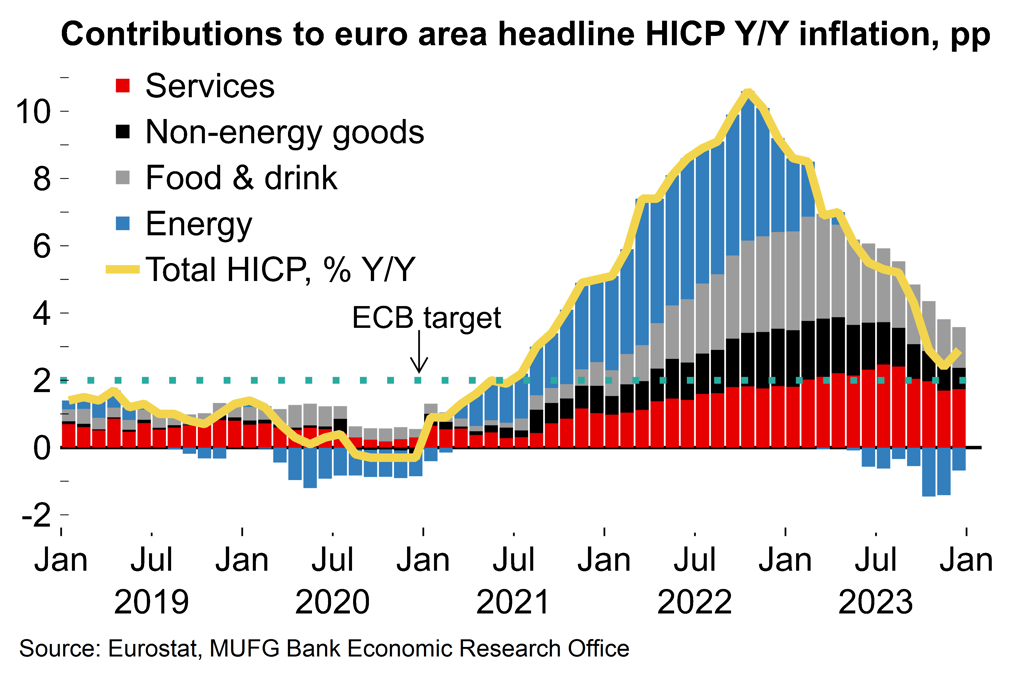
Chart 6: Wage growth is a lagging indicator
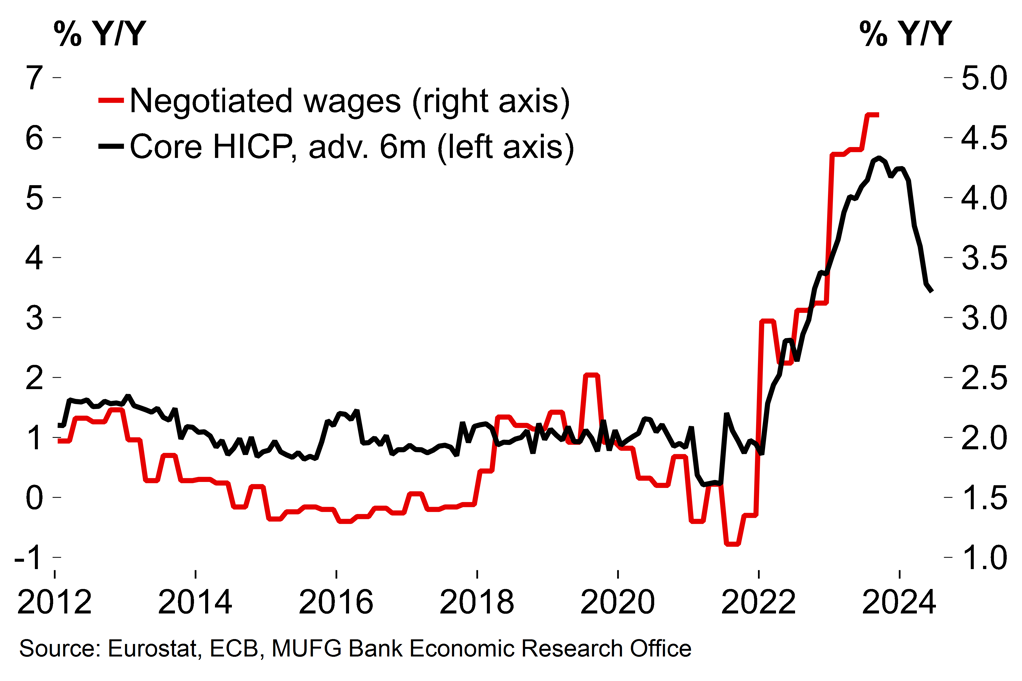
At next week’s meeting the focus will be on the timing of these rate cuts. As well as Lagarde’s comments, we’ve seen a range of ECB officials out ahead of the pre-meeting quiet period to push back against market expectations for rate cuts early this year. Most significantly, ECB chief economist Philip Lane highlighted that there will be “important data” on wage growth available to policymakers by the June meeting – mentioning a specific month feels like a significant intervention. However, market participants are still pricing in around 18bp of cuts at the prior meeting in April, so there may be further work to do if officials are looking to resist a premature easing of financial conditions.
That may be a tough ask against the clear trend of disinflation last year and a sluggish euro area economy. Yes, headline inflation edged up in December (Chart 5), but we think that was just a blip (see here). We also expect confirmation that the euro area economy has slipped into technical recession when the Q4 national accounts are released at the end of this month. Against that background, holding off on rate cuts until the summer will be a communication challenge for the ECB – not least because the official HICP projections will likely be revised lower at the next update in March on the back of lower energy costs and ongoing easing in underlying inflation pressures.
Based on Lane’s interview, it seems as though policymakers will lean on the fact that wage growth is still high as a reason to hold off declaring victory over inflation for a while yet. There are credible reasons to be cautious: the euro area unemployment rate fell to an all-time low of 6.4% in November with sluggish demand not yet translating into clear labour market loosening. The euro area wage tracker from Indeed, the jobs board, also edged higher in December to 3.9% Y/Y. This is not that inconsistent with the ECB’s inflation target with reasonable productivity growth assumptions, and the general trend remains downwards. We’d also highlight that wage growth is a lagging indicator when it comes to inflation (Chart 6). But the bottom line is that the ECB is wary of second-round effects from wage growth on inflation – or at least wants to seem that way to avoid loosening financial conditions – and does not yet seem ready for a dovish pivot of the sort seen from the Fed in December.
Key data releases and events (week commencing Monday 22 January)
